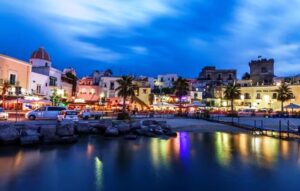IDYLLIC ISCHIA – CAPRI’S BEAUTIFUL ISLAND NEIGHBOUR
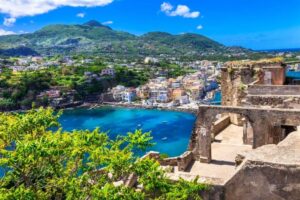
Rising from the crystal clear azure waters of il Golfo di Napoli, the island of Ischia has been a sough-after destination by visitors for centuries. Covered with lemon trees, vineyards and olive groves, Ischia is a beautiful, volcanic island that’s a haven for those seeking a beach holiday off the beaten track, but also for those interested in its vibrant, often violent, history dating back thousands of years. Here, glamorous hotels mix with more secluded accommodation dotted along its rugged coastline, all juxtaposed with healing hot springs, traditional residential neighbourhoods, religious street parades and zooming Vespas.
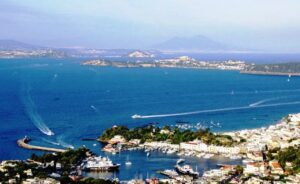
Ischia lies at the northern end of the Gulf of Naples in the Tyrrhenian Sea, about 30 kms from Naples and is the largest of a group of islands called the Phlegrean Islands. Ischia is a little more than 46 kms in area, approx. 10 kms east to west and around 7 kms north to south. It’s a very densely populated, volcanic island and almost entirely mountainous, with its highest peak, Mount Epomeo, at 788 m. It has been known since ancient times for its thermal waters and gardens, and its volcanic nature makes Ischia one of the largest spa destinations in Europe.
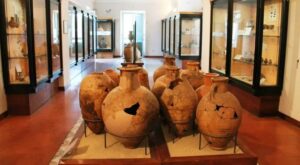
Early settlers appreciated and used the waters of the island’s thermal springs. The Greeks also used the waters as a remedy for healing the after-effects of war wounds (in the pre-antibiotic era), and even attributed supernatural powers to the waters and vapours that gushed from the earth. The Greek historian and geographer Strabo mentioned Ischia and the virtues of its thermal springs in his writings. The later Romans raised the uses of the thermal springs to new heights by creating public Thermae for care and relaxation, and erected a small temple dedicated to Apollo and the Nitrodie Nymphs (guardians of the waters). Unfortunately, volcanic eruptions and earthquakes over the ensuing centuries have eliminated any vestiges of these structures. The decline of the power of Rome coincided with the abandonment of the use of these bathing facilities in Ischia, and there are no traces of the use of the waters in the Middle Ages.
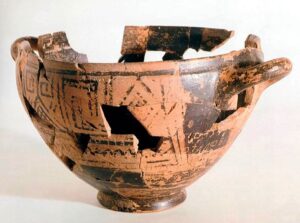
An acropolis site in the Monte Vico area of the island was inhabited from the Bronze Age, as Mycenean and Iron Age pottery sherds attest, and further archaeological evidence suggests Ischia has been fully settled since the 8th century BCE. This settlement was a mixed population of Greeks from Magna Graecia, Etruscans and Phoenicians. Its fine harbour was safe from raiders coming by sea, and trade in iron and was established with the mainland Etruscans.
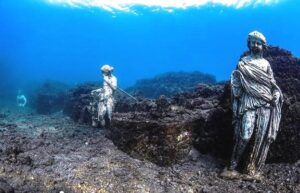
The Romans seized Ischia in 322 BCE, but ownership and control of the island was contested by invaders ranging from Ostrogoths, Byzantines, Dukes of Naples, Saracens, German princes, Kings of Sicily, raiding Pisans, and the Aragonese, who conquered it in 1284, but who ultimately succumbed to Charles II of Anjou. However, nature had the last word when the volcano erupted in 1302. Some of the population sought refuge in the ancient Castello Aragonese, but most fled to Baia across the Bay of Naples, where they remained for 4 years. This was the last volcanic eruption on Ischia.
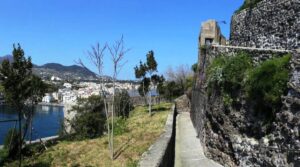
Since the Middle Ages, control of this strategic outpost has passed between a number of conquerors and dynasties in time with the complex history of all of southern Italy that saw the island passing back and forth yet again from Aragon to Anjou. In 1495, Ferdinand II of Naples landed on the island and took possession of the ancient castle that had been erected by Hiero I of Syracuse back in 474 BCE, who had named it Castrum Gironis. Ferdinand set up a governor, the Marquis of Pescara, who ably defended the place from the French flotilla, and ultimately established a dynasty on the island that lasted into the 18th century.
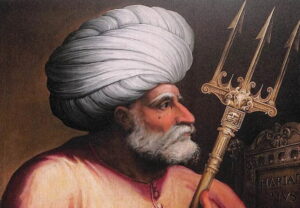
During the 16th – 18th centuries, the island suffered many incursions of pirates and Barbary privateers from North Africa, included the dreaded Barbarossa. Better defences, including more defensive walls and two towers added to the Castello, meant invasions became increasingly rare, which encouraged the local population to venture out from the protection of the castle and establish a town. By the end of the 18th century, Ischia had been taken by the Bourbons, and administered by a royal governor who based himself within the castle. During the 19th century, a revolt was put down by a British-Bourbon fleet, relative peace returned, and the island became a popular travel destination for European nobility.
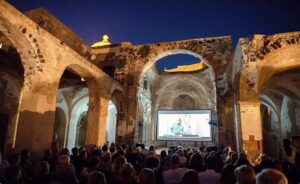
Ischia developed into a well-known artist colony at the beginning of the 20th century. Writers and painters from all over the world were attracted to its beauty and tranquil atmosphere. Spa tourism though didn’t resume again until the early 1950s, and by that time, there was quite a colony of famous arts, writers, composers and people from the world of film, such as Elizabeth Taylor and Luchino Visconti, who stayed on Ischia while filming. The island is home to the Ischia Film Festival, an international cinema event celebrated in June or July, specifically for films promoting the island and local values.
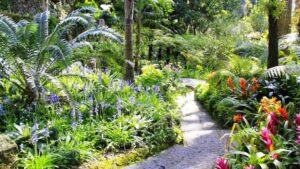
Other notable temporary or permanent residents include Giuseppe Garibaldi, who stayed on the island to recover after a serious injury. The poet W. H. Auden spent time there, and the British composer, Sir William Walton and his wife sold their London house, put their Bentley on a ferry and took up full-time residence on Ischia. He built a hilltop house that he called La Mortella at Forio, and Susana Walton created a magnificent garden. They grew myrtle bushes (whose leaves and berries flavour mortella, a potent Italian liqueur), as well as orchids, rosemary and lavender. William Walton died there in 1983, and today the property is open to all. Visitors can stroll past fountains and ponds along hillside paths, as honeysuckle scents the air. A visit to La Mortella is a highlight of a stay on Ischia.
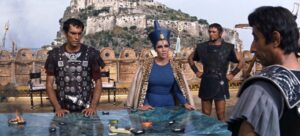
Quite a number of films have been set on Ischia over the years including The Crimson Pirate in 1952, Avanti! starring Jack Lemon and Juliet Mills in 1972, part of Cleopatra starring Elizbeth Taylor in 1963, And While We Were Here in 2012 and Men in Black: International in 2019.
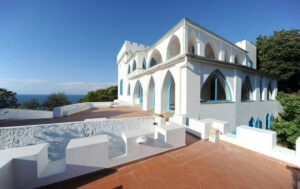
Villa La Columbaia (“The Dovecote”) is located in the Lacco Ameno and Forio territories on the island. Surrounded by a park, the villa was commissioned by Luigi Patalano, a famous local socialist and journalist. It is now the seat of a cultural institution and museum dedicated to Luchino Visconti. The institution promotes cultural activities such as music, cinema, theatre, art exhibitions and workshops. The villa and park are open to the public.
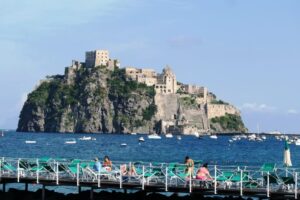
The most prominent landmark on Ischia without doubt, is the Castello Aragonese on Ischia Ponte. It was connected to the island by a stone bridge by Alfonso V of Aragon in 1441, who also further fortified the walls. The bridge is now a 220m long causeway. Around 1700, about 2,000 families lived on the islet, including a Poor Clares convent, an abbey of Basilian monks (a Greek Orthodox order), the bishop and a seminary, the prince and a military garrison.
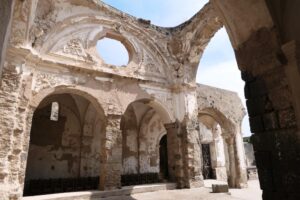
There were also 13 churches. It was almost totally destroyed in 1809 by British shells when the island was under French control. After the unification of Italy, the castle became Italian state property and was largely abandoned and left as ruins. In 1912, it was sold to a private owner, and today, it is the most visited monument on the island.
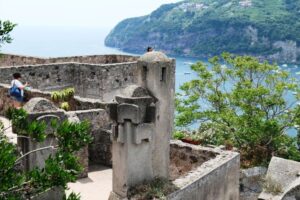
It is accessed through a tunnel with large openings which allows light to enter. Until the tunnel was built in the mid-15th century, the fortress could only be accessed from the sea via a ladder. Today, as well as the tunnel access, there is an elevator that, for a small fee, whisks visitors to the top.
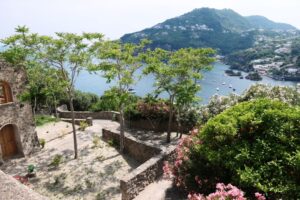
The views from the top are stupendous. There are snack bars, a good souvenir/bookshop and an art exhibition space inside the castle complex. From Ischia Porto, bus No. 7 goes to the edge of the island from where you walk across the stone causeway.
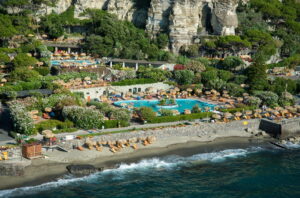
Ischia’s thermal hot springs have been drawing visitors for centuries. There are numerous thermal parks from which to choose. One of the most famous thermal parks on the island is Poseidon Thermal Gardens, located on the beautiful Citara Bay. With over 20 pools of varying temperatures and mineral compositions, Poseidon offers a truly immersive experience. Surrounded by lush Mediterranean vegetation and offering breathtaking views of the sea, visitors can indulge in rejuvenating spa treatments, mud therapies and massages, or simply relax in the warm embrace of the mineral-rich waters. Several buses serve the area as well as ample parking for those with a rental car.
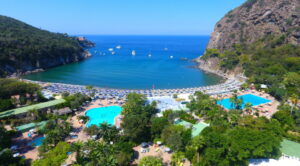
Another outstanding thermal park is Negombo, situated in the picturesque San Montano Bay. This park, designed by renowned architect Paolo Soleri, offers an enticing blend of modern design and natural beauty. The 12 pools at Negombo range from sea-wader pools to thermal pools, allowing visitors to experience the full spectrum of Ischia’s healing waters. The park also has a private beach, tropical gardens and the obligatory spa treatments. Buses or taxis from the nearby town of Lacco Ameno will get you there.

Part of any vacation is exploring the local food and wine, and Ischia has a delectable food and wine tradition that is both quite affordable and authentic to the island. One local delicacy is the Coniglio all’Ischitana—Ischian rabbit stew—complete with local olive oil, tomato and rosemary. Don’t forget to sample anything and everything lemon or orange, as there are plenty of citrus fruits grown on the island.
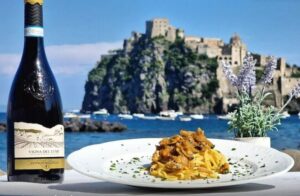
Most of Ischia’s wines are cultivated on the mountainous slopes of the island’s interior. Seven different types are categorised with the island’s DOC: Ischia Bianco, Ischia Bianco Spumante, Forastera and Biancolella (whites); Ischia Rosso, Per’e Palummo and Per’e Palummo Passito (reds). Tasting tours to vineyards such as Cenatiempo and Pietratorcia are available, and any wine bar/restaurant offers good lists of local wines.
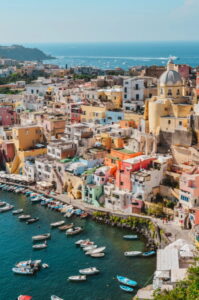
Most of the main towns clustered long the north coast of the island are a picturesque mix of spa hotels, beachfront trattorias and delightful walking pathways lined with palm trees. On the south coast, the charming small village of Sant’Angelo is the chic corner of Ischia, where whitewashed houses atop high cliffs, and from where you can take a water taxi to one of the best beaches in Ischia, Spiaggia dei Maronti.
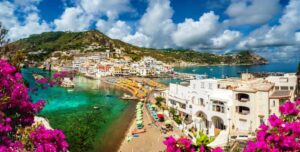
Sant’Angelo has been built next to a giant rock with a small strip of beach that joins the two parts of the village. There are shops, restaurants and cafes that are the perfect location to watch the boats in the small marina and to take in the views across the Tyrhennian sea. Close by to Sant’Angelo is Le Fumarole Beach, which is famous for its ‘Fumaroles of Sant’Angelo’, jets of steam that rise up through the sand, that was created by the volcanic activity underneath the island. The sand is so hot in places that locals use specially-made containers to cook food, such as chicken or eggs, under the sand. The beach is accessed from a path that leads from the centre of Sant’Angelo and winds its way around the hilltop houses of the town, giving fantastic panoramic views across to the nearby Maronti beach and the island of Capri in the distance.
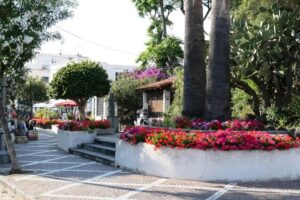
Getting to Ischia is easy. Regular car ferries from Naples take about 1hr 35mins, or the hydrofoil which takes around an hour. If you also want to visit nearby Capri as well, due to the ferry timetables, it made more sense for us to go to Ischia first, then take the ferry across to Capri, which takes 50 mins. After enjoying a stay on Capri, you can decide to either head back to Naples on a direct ferry, or take a direct ferry across to Sorrento. Both islands are wonderful holiday destinations, each with their own personality and characteristics, and worthy of at least a couple of days on each, rather than the frustration of only a day trip to either—you cannot do justice to them, as there’s far too much to see and enjoy. Once you’re on these spectacular islands, you will not want to leave in a hurry!
